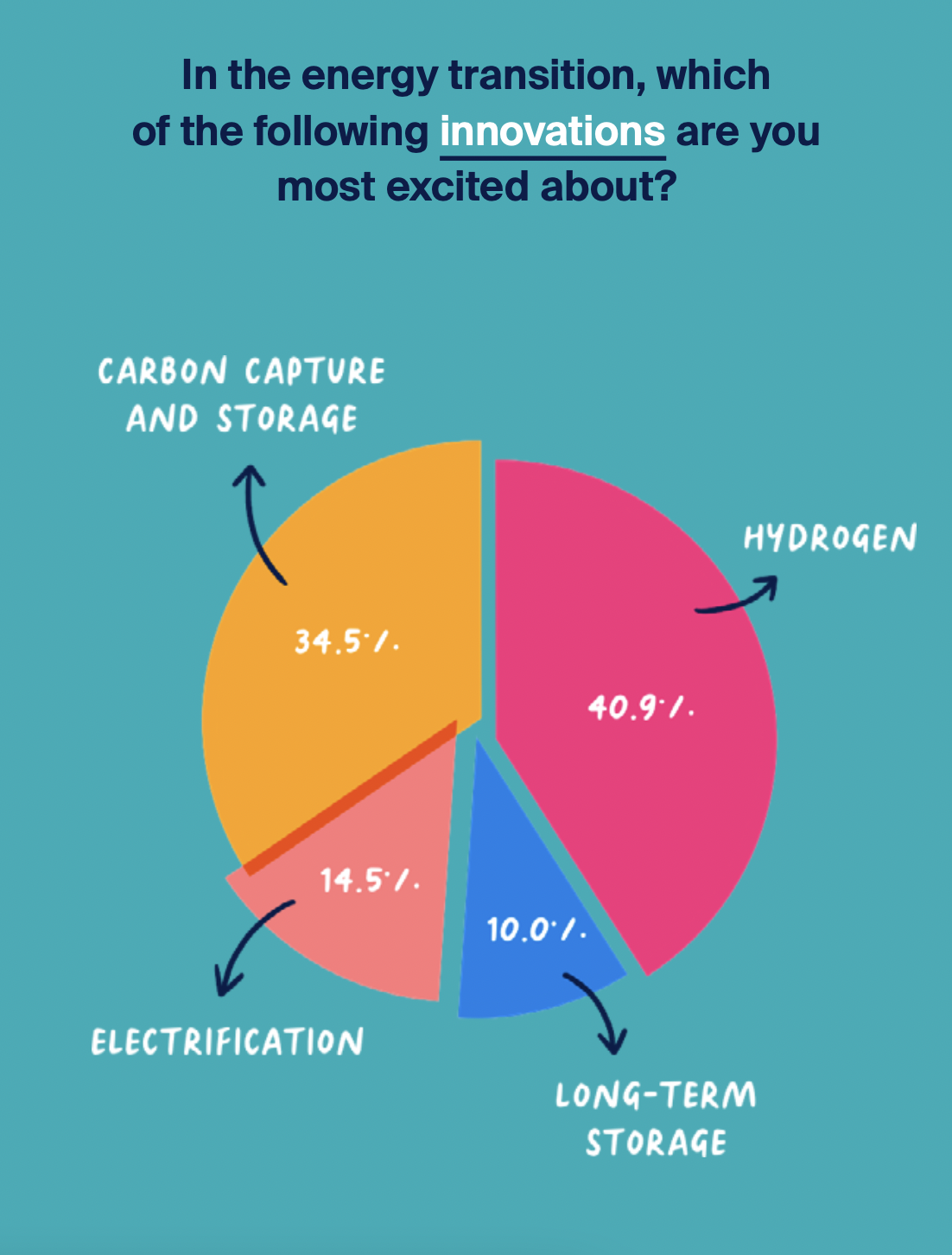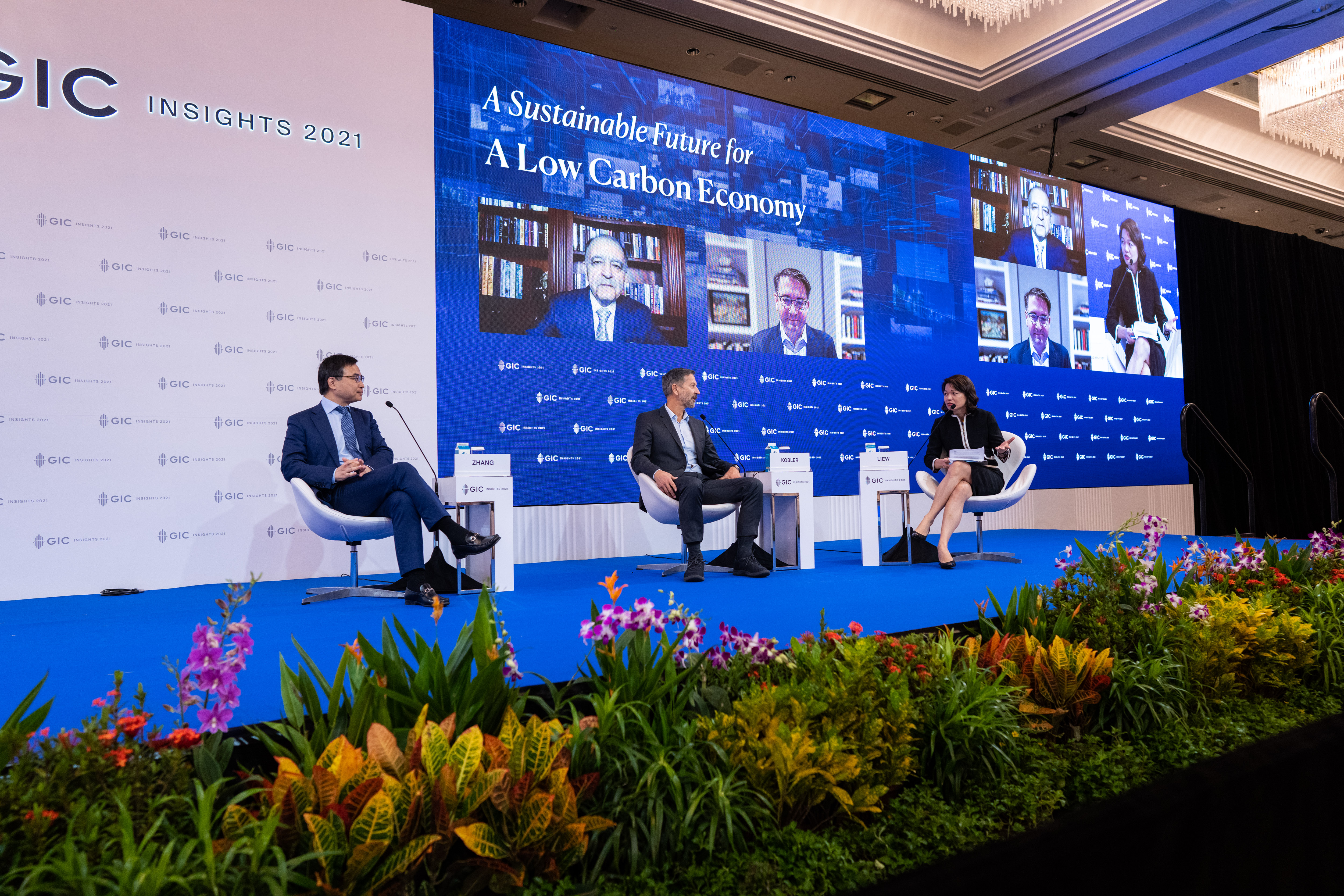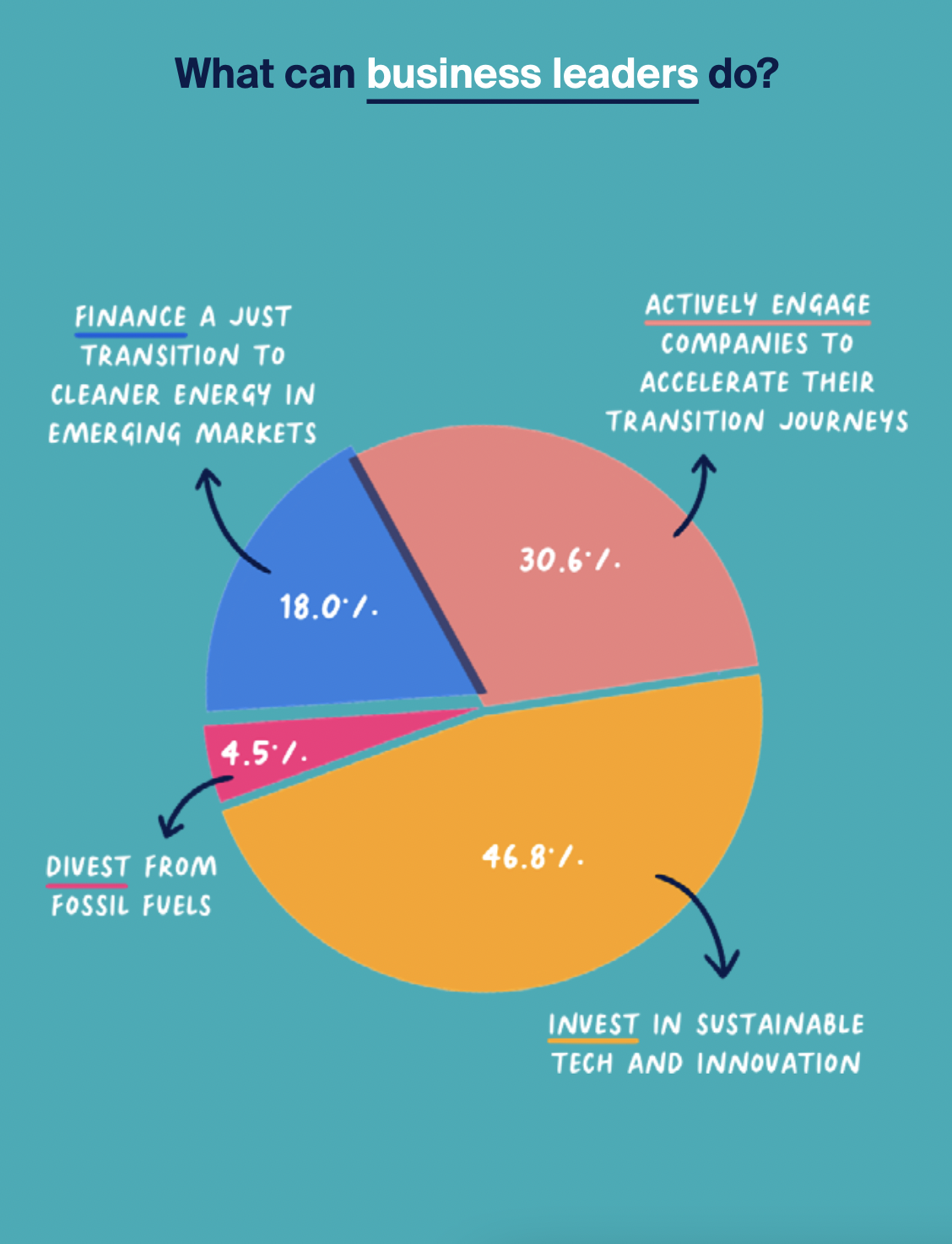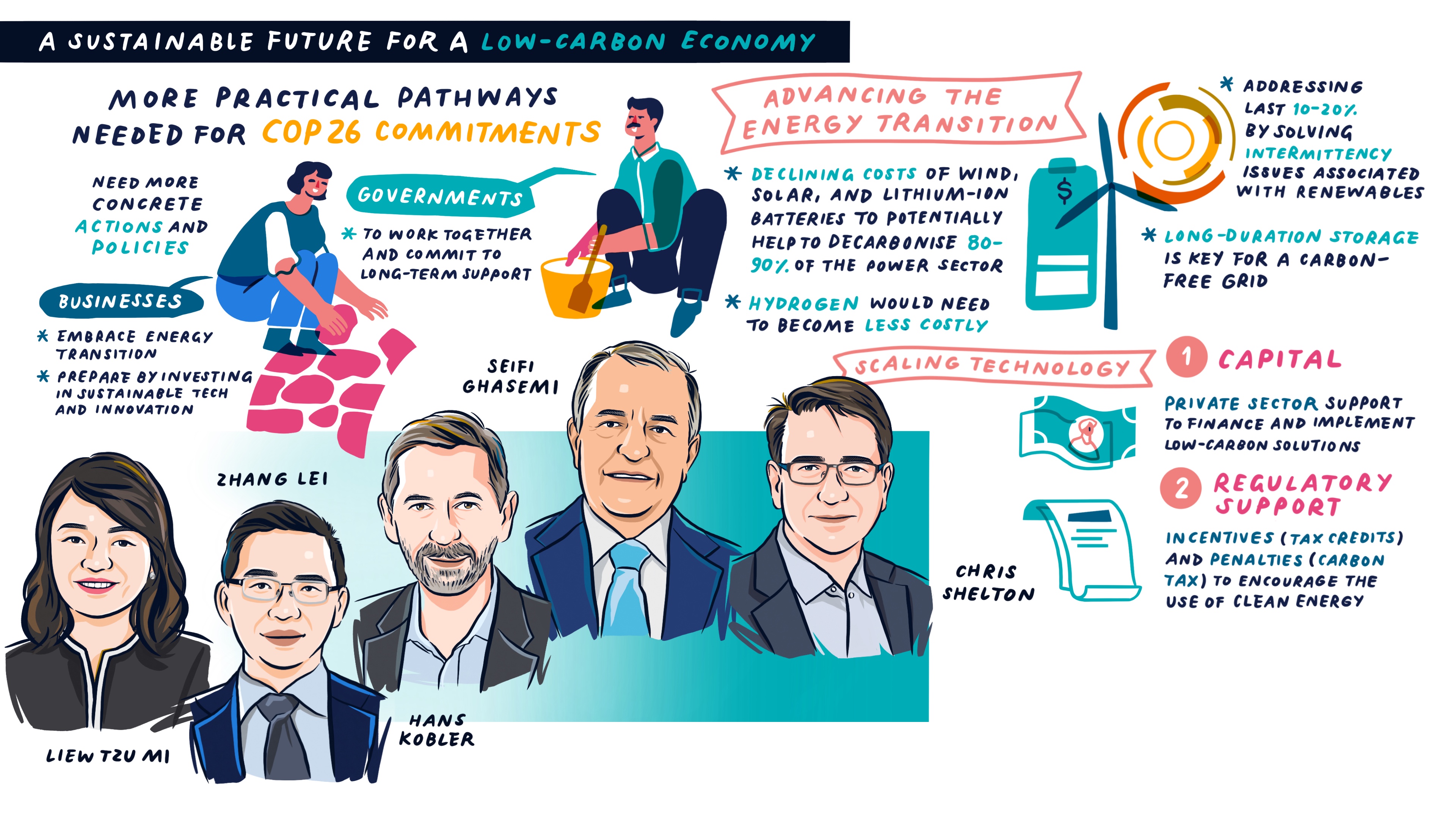This article presents takeaways from the panel at GIC Insights 2021 featuring Lei Zhang, CEO of Envision Group; Hans Kobler, Founder and Managing Partner of Energy Impact Partners; Seifi Ghasemi, Chairman, President and CEO of Air Products; and Chris Shelton, Chief Product Officer of The AES Corporation, and President of AES Next.
Moderated by Liew Tzu Mi, Chief Investment Officer of Fixed Income and Chair of the Sustainability Committee at GIC, the speakers discussed what the most critical solutions to accelerate the energy transition are, and what role governments and private capital can play in this journey towards a low-carbon, sustainable future.
COP26 has seen ambitious commitments made to tackle everything from deforestation to methane emissions to the phasing out – or down – of fossil fuels. According to the panel, it remained to be seen, however, whether these lofty announcements would translate into tangible climate action to meet the temperature goals set by the Paris Agreement.
It was also acknowledged that while the resolve by governments and the private sector to address the climate crisis was undeniable, the practical pathway to get to these commitments was less clear. Transitioning from fossil fuels to clean sources of energy in the long term while adopting low-carbon technologies that can drive decarbonisation efforts now would without a doubt form a critical part of net zero plans.

Long-duration storage is key
With a steady decline in costs, the speakers discussed that wind, solar and lithium-ion batteries had the potential to decarbonise 80 to 90% of the power sector. Addressing the remainder 10 to 20% would be contingent on resolving the intermittency issues associated with renewables. With increased solar and wind capacity, long-duration storage including multi-day and seasonal storage could be critical to turning renewables into round-the-clock resources and to paving the way for a carbon-free grid.
While lithium-ion batteries are best suited for daily storage and distribution of energy, solutions such as iron-air rechargeable batteries could potentially store electricity for up to 100 hours.
It was also mentioned that long-duration storage still lacked the critical breakthrough to scale, and that most companies in this space were still in the process of proving that their technology is reliable, and that their business model could be cost-effective and sustainable over the long term.
Is hydrogen the future?
In addition, in certain hard-to-abate sectors such as heavy industries, including steel, cement and aluminium, chemical production, or heavy-duty transport such as shipping, trucking or aviation, electrification is challenging because of high costs or reliability issues.
The panel observed that hydrogen could provide these sectors with the means to decarbonise. Hydrogen burners, together with electric heating, could help generate the high temperatures required in heavy industrial processes. Meanwhile, the transport sector could swap fossil fuels for hydrogen fuel.
However, green hydrogen, the cleanest form of hydrogen produced from surplus renewable energy sources using a process called electrolysis, makes up a small percent of overall hydrogen production, mainly because of the cost gap with hydrogen from unabated fossil fuels.
Blue hydrogen which is produced from natural gas or methane, and where the carbon generated is captured and reused or stored underground, could offer an interim solution.
To be economic, it was noted, hydrogen would ultimately need to become significantly less costly.
Introducing the net zero industrial park
The panel introduced the concept of the net zero industrial park which combines many of these low-carbon solutions, including wind, solar and hydrogen, as well as battery and electric vehicle (EV) manufacturing, in a single location. By integrating energy production, storage and consumption, it aims to eliminate the need to build costly long-distance transmission lines, address challenges related to intermittency, and provide a low-cost and reliable 24-hour source of electricity.
The first pilot project is being built in Ordos, Inner Mongolia with the objective of assisting the net zero transition of a traditionally coal-producing region. The park will be connected by an electric truck transportation network and will be managed by an Artificial Intelligence of Things (AIoT) operating system. It essentially brings together e-mobility, renewable energy and smart digital solutions in a systems-based approach.
Financing the energy transition
The panel discussed that while climate tech had undoubtedly gone mainstream, with valuations doubling and deal sizes increasing by 50 to 70%, more capital was needed than ever to accelerate the clean energy transition. Investor support would be key for both existing solutions such as wind, solar and batteries, and emerging technologies such as green hydrogen, long-duration storage or carbon capture and storage (CCS) to scale.
The International Energy Agency (IEA) estimated that to reach net zero by mid-century, global clean energy investment would need to more than double by 2030 – from just over US$2 trillion to almost US$5 trillion per annum.
To address the potential risk of climate tech turning into another dot-com bubble, the speakers explained that unlike many of the businesses that had gone bust during the Internet bubble, climate tech investors were dealing mostly with real companies working on real technologies. The investment required might be higher compared to the Internet, but so are the opportunities.

“By integrating energy production, storage and consumption, a net zero industrial park aims to eliminate the need to build costly long-distance transmission lines, address challenges related to intermittency, and provide a low-cost and reliable 24-hour source of electricity."
The need for more regulatory support
It was also observed that a more enabling regulatory environment would be crucial to both increase clean energy production and galvanise demand by consumers.
For example, Germany’s recently reformed Renewable Energy Sources Act (EEG), which was originally enacted 20 years ago, set grid priority for onshore wind, solar and biogas, and provided them with generous feed-in tariffs. As a result, together with hydro and offshore wind, these renewable sources of energy now cater to almost half of the country’s electricity consumption.
It was noted that policymakers must also commit to long-term support. Spain and Italy had introduced feed-in tariffs for solar, only to then cut back on these incentives which decimated the industry.
Tax credits for renewables in the US were mentioned as another example of incentivising clean energy projects, although the panellists cautioned that the “carrot” approach might not be sufficient without the “stick”—a potential global carbon tax on polluting industries.
The panel agreed, however, that it might be challenging to get governments around the world to agree on a universal carbon price. According to the International Monetary Fund (IMF), only one-fifth of global emissions are currently covered by pricing programmes, and the global average price is a mere US$3 a ton compared to the approximate US$75 a ton required to keep global warming below 2°C above pre-industrial levels.
IMF data has also shown that fossil fuel subsidies made up US$5.9 trillion—or 6.8% of global GDP—in 2020. Without putting a price on carbon and cutting back on fossil fuel support, the panel discussed that green hydrogen would struggle to compete with its oil and gas or coal competitors.

Ultimately, climate change will impact every country, industry and company. The panel concluded that the private sector must play a significant role in advancing the low-carbon transition, and shared a few suggestions on what business leaders should do to shape a more sustainable economy:
- Embrace the energy transition and prepare your business for it.
- Set near-, medium- and long-term climate targets and engage the whole company in your sustainability efforts.
- Work towards and support cost-competitive and scalable low-carbon technologies.
- Identify and understand where the opportunities or threats are.
- Take risks and make bold decisions.
- Seek out and work together with like-minded partners.
Click on “Save as PDF” to access the pdf version of the article.







